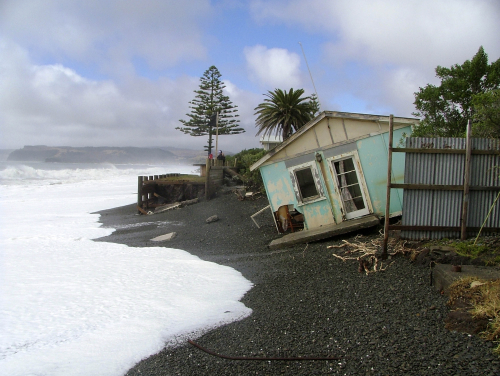
New study helps shift seal-level rise decision-making towards long-term solutions

A significant proportion of New Zealand’s population is under increasing threat from sea-level rise – 300,000 residents live below 3m land elevation.
Currently the impacts are felt as coastal erosion and occasional flooding during king tides and storms. “They are happening more often, and we’re seeing a shift over time to coastal flooding becoming the dominant coastal risk over erosion due to rising sea levels,” says Dr Rob Bell from NIWA.
This is the reality faced by coastal Hawke’s Bay communities who have successfully collaborated with their councils and iwi to develop a Coastal Hazards Strategy. Extending out to 2120, the strategy breaks new ground in shifting the focus to the dynamic changes caused by climate change.
New research funded by the Resilience to Nature’s Challenges ‘Living at the Edge‘ programme examined how the Councils worked with communities to shift decision making towards more long-term, sustainable adaptation options and highlighted the lessons learned from that process that may help other communities. .
The big challenge with planning discussions like these is finding a way to consider and allow for the dynamic nature of climate change, and the associated uncertainties.
“We know that the sea is rising, and have a good estimate on the range of sea-level rise up to about 2050. After that we are much less certain as we don’t know the exact timing of change, including polar ice sheet responses, nor how fast the world will reduce its carbon emissions. So decisions about settlements beside the sea need to be made with precaution and the flexibility to shift pathways” says Dr Judy Lawrence, one of the researchers involved in the study.
The combined use of Dynamic Adaptive Pathways Planning (DAPP) with the more traditional tools addressed this issue, and the result could be seen in the community’s shift towards a longer term view of the consequences of taking short-term actions today and the use of physical adaptation as a transition to the long-term.
“We must start making transitional changes to transform our coastal communities as seas rise and coastal flooding becomes an unavoidable reality. Moving away from thinking we can continue to stop the sea by using hard structures is a first step. Holding the shoreline has limits, not least being affordability. There are adaptation choices, but they will require lead-time to implement.” says Dr Lawrence.
The research approach used is a first for coastal management in New Zealand, and has been embedded in the 2017 Ministry for the Environment’s revised Coastal Hazards and Climate Change Guidance for local government.
Resilience to Nature’s Challenges is one of eleven MBIE funded National Science Challenges. It is increasing the resilience of Aotearoa New Zealand by building new knowledge and tools that underpin a broad-spectrum resilience in our unique rural, urban, coastal and Māori communities to natural hazards, including earthquakes, volcanoes, landslides, tsunami, weather, coastal and rural fire hazards.
Disclaimers and Copyright
While every endeavour has been taken by the East Coast Lab Hikurangi Subduction Zone M9 to ensure that the information on this website is
accurate and up to date, East Coast Lab Hikurangi Subduction Zone M9 shall not be liable for any loss suffered through the use, directly or indirectly, of information on this website. Information contained has been assembled in good faith.
Some of the information available in this site is from the New Zealand Public domain and supplied by relevant
government agencies. East Coast Lab Hikurangi Subduction Zone M9 cannot accept any liability for its accuracy or content.
Portions of the information and material on this site, including data, pages, documents, online
graphics and images are protected by copyright, unless specifically notified to the contrary. Externally sourced
information or material is copyright to the respective provider.
© East Coast Lab Hikurangi Subduction Zone M9 - www.eastcoastlab.org.nz / +64 6 835 9200 / info@eastcoastlab.org.nz
